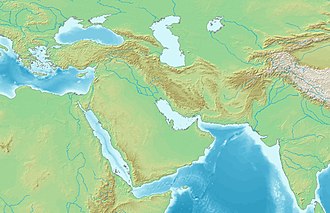 The relief in 2016 | |
| Location | Sarpol-e Zahab, Kermanshah, Iran |
|---|---|
| Coordinates | 34°27′48″N45°52′06″E / 34.4633°N 45.8683°E |
| Type | Rock relief |
| History | |
| Founded | c. 2300 BC |

The Anubanini petroglyph , also called Sar-e Pol-e Zohab II [1] or Sarpol-i Zohab relief, [2] is a rock relief from the Akkad period (circa 2300 BC) or the Isin-Larsa period (early second millennium BC) and is located in Kermanshah Province, Iran. [2] [1] The rock relief is believed to belong to the Lullubi culture and is located 120 kilometers away from the north of Kermanshah, close to Sarpol-e Zahab. Lullubi reliefs are the earliest rock reliefs of Iran, later ones being the Elamite reliefs of Eshkaft-e Salman and Kul-e Farah.
























